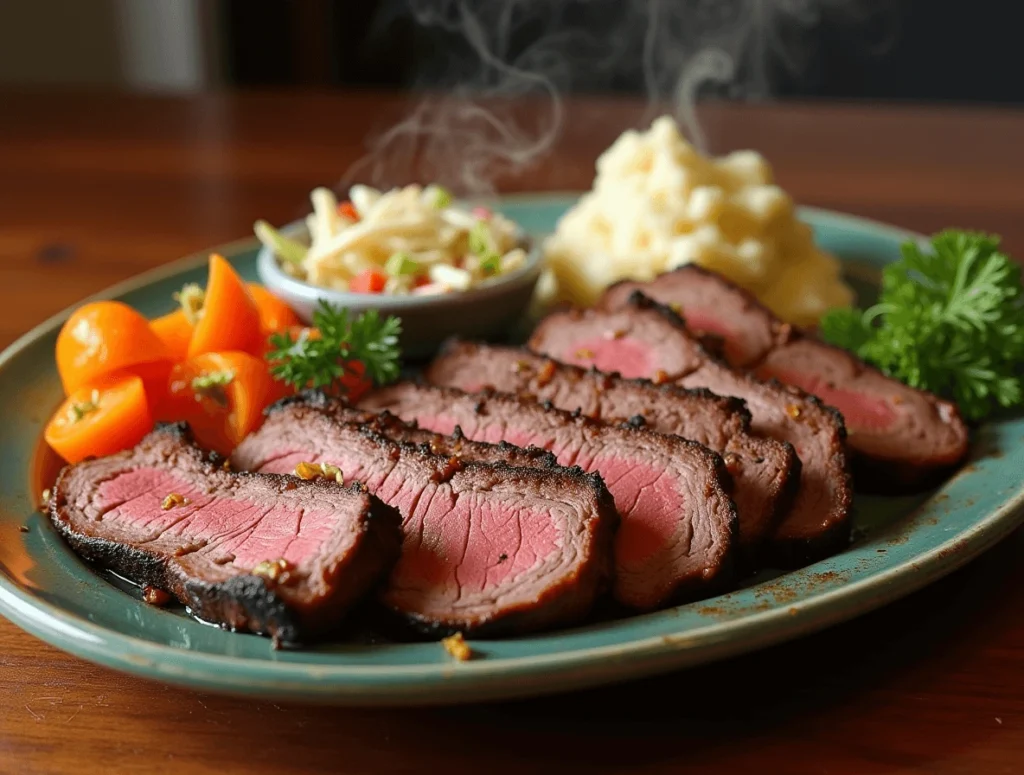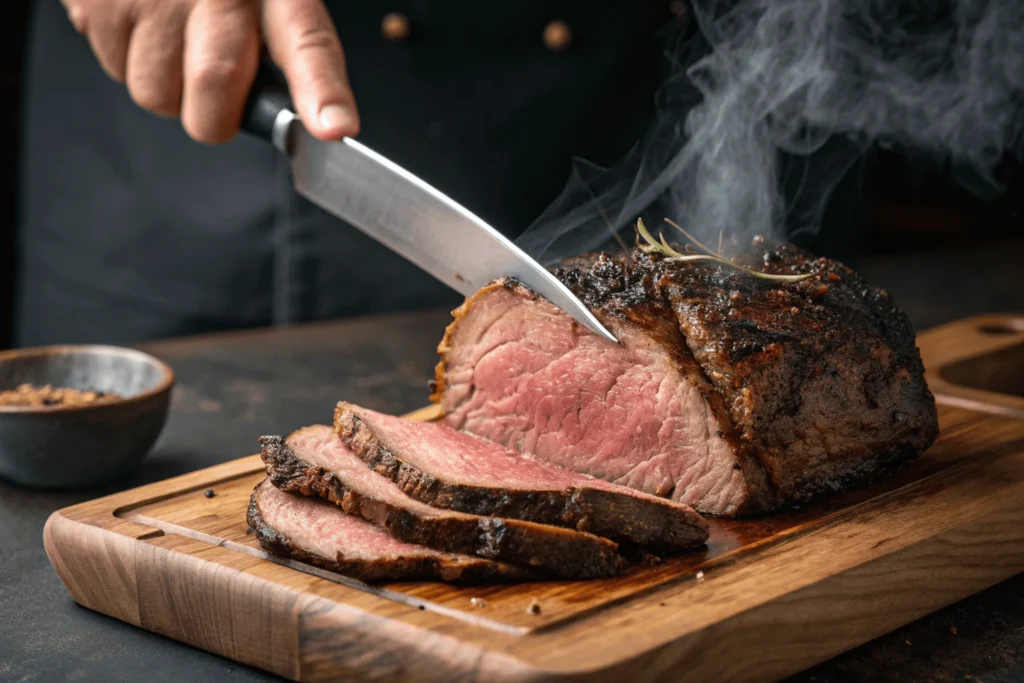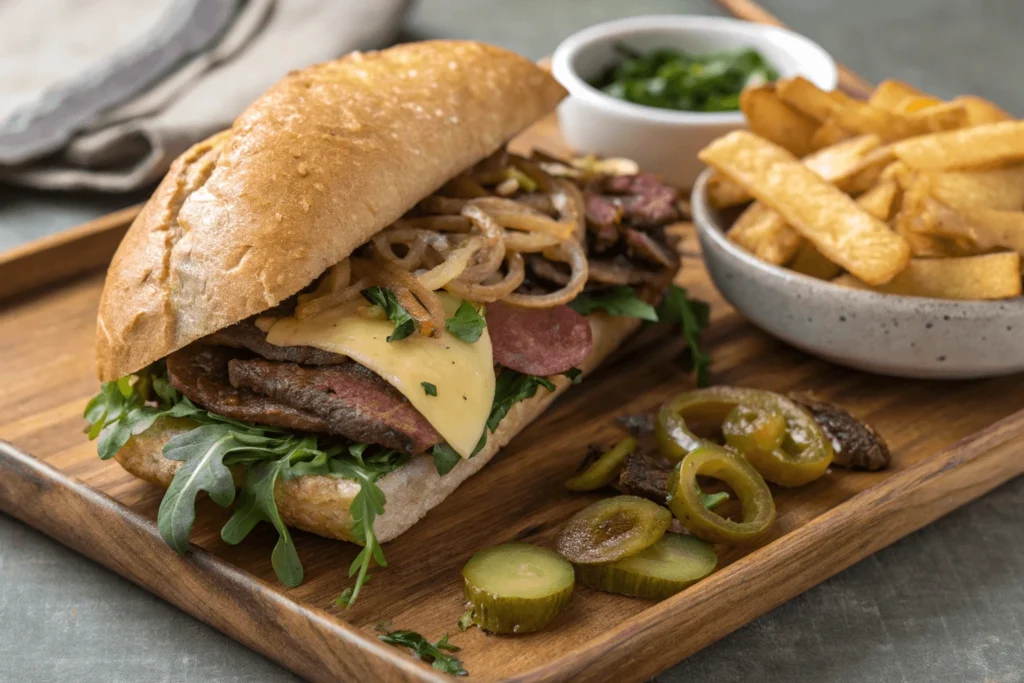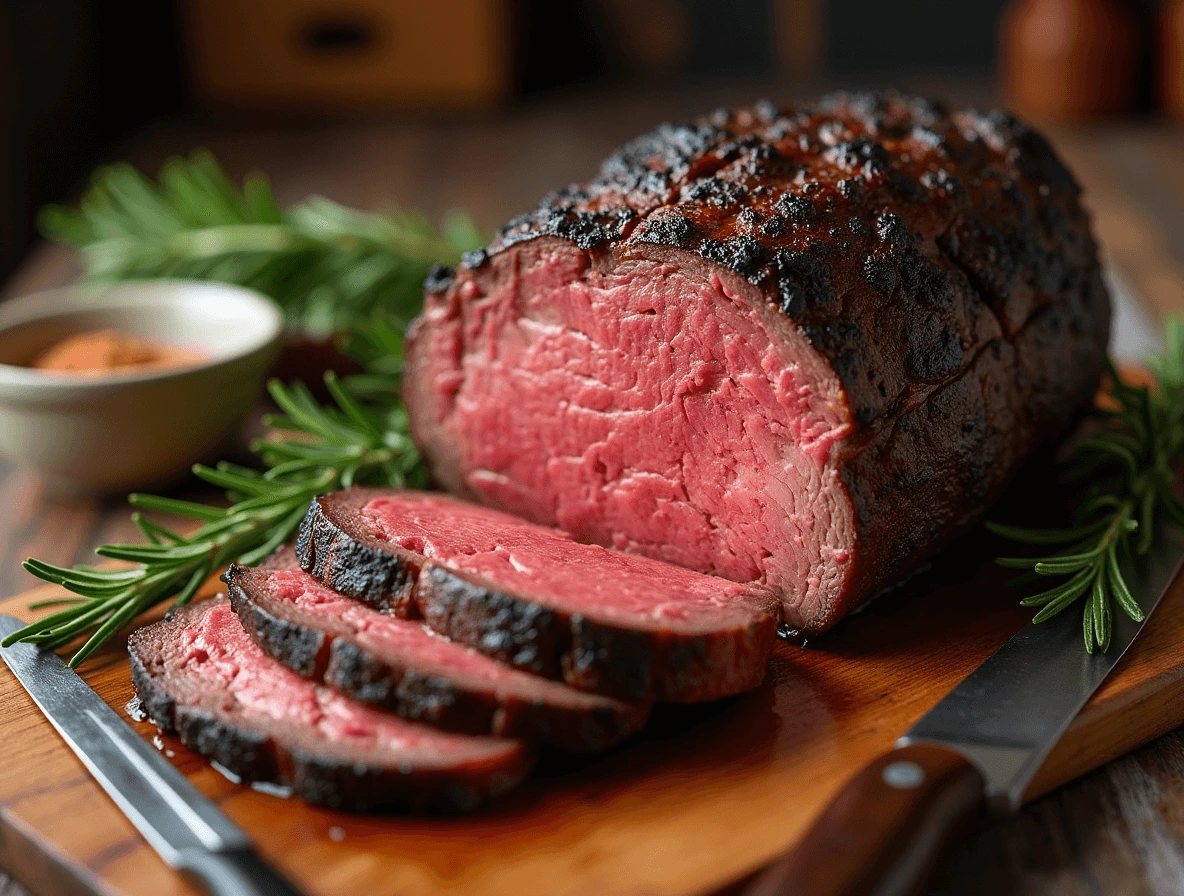Table of Contents
A smoked beef roast is the epitome of comfort food, combining rich, savory flavors with tender, juicy meat that melts in your mouth. Whether you’re hosting a special occasion, a family gathering, or simply looking to elevate your dinner menu, this dish never disappoints. Smoking beef adds a unique depth of flavor that traditional roasting just can’t match. The slow process infuses the meat with a smoky essence, creating a deliciously complex taste profile. From selecting the perfect cut of beef to mastering the art of smoking, this guide will walk you through everything you need to know to create the ultimate smoked beef roast that will have your guests asking for seconds. Let’s dive in and explore the magic behind this mouthwatering dish!

Choosing the Right Cut of Beef for Smoking
Best Cuts for Smoking (e.g., Brisket, Chuck Roast, Ribeye)
When it comes to smoking beef, the right cut of meat can make all the difference. Smoking works best with cuts that are rich in fat and connective tissue, as these elements break down slowly during the cooking process, resulting in a tender and flavorful roast. Here are some of the best cuts for smoking:
RELATED : Everything You Need to Know About Beef Recalls
1. Brisket
Brisket is widely considered one of the most popular cuts for smoking. This cut comes from the lower chest of the cow and is known for its tough texture, which makes it perfect for low-and-slow cooking methods like smoking. The long smoking process helps break down the collagen and fat, turning the brisket into a melt-in-your-mouth experience. The result is a deeply flavorful roast with a beautiful smoke ring and a crispy, flavorful bark. Brisket can take anywhere from 10 to 15 hours to smoke, depending on the size and thickness, but the effort is well worth it for the tender, juicy meat it produces.
2. Chuck Roast
Chuck roast, often used for pot roast, is another excellent choice for smoking. This cut comes from the shoulder area and has a good amount of marbling, making it flavorful and tender when cooked slowly. While not as famous as brisket, chuck roast is more affordable and can yield a fantastic smoked roast with deep, rich flavors. Smoking a chuck roast takes around 4 to 6 hours, and it can be sliced or shredded depending on your preference. Many people choose to smoke a chuck roast for pulled beef sandwiches or tacos because of its ease of shredding and rich taste.
3. Ribeye
Ribeye is a favorite among steak lovers, and it can also be an excellent choice for smoking. This cut is well-marbled with fat, which ensures a juicy and flavorful roast. Smoking ribeye adds a unique smoky flavor that enhances the beef’s natural richness. While it’s typically prepared as individual steaks, smoking a whole ribeye roast gives it a more robust, smoky profile while maintaining its tenderness. Because ribeye cooks faster than brisket or chuck roast, it may only take around 3 to 4 hours, depending on the size. It’s a great option for those who prefer a quicker, yet still smoky, roast.
4. Tri-Tip
Tri-tip is a lesser-known cut from the bottom sirloin, but it’s gaining popularity for smoking. It’s smaller than brisket and chuck roast, making it perfect for smaller gatherings. With a slightly leaner texture than brisket, tri-tip still delivers great flavor when smoked. It tends to have a nice crust when properly seasoned, with a juicy and tender interior. Tri-tip usually takes around 3 to 4 hours to smoke, making it a faster option than brisket or chuck roast. It’s perfect for those looking for a delicious roast without the long smoking times.
5. Round Roast
Round roast, especially from the top or bottom round, is a leaner cut that can still work well for smoking, though it requires careful attention to ensure it doesn’t dry out. Since it has less fat than other cuts, it’s important to keep the smoker at a lower temperature and watch the internal temperature closely. Round roast can make a great smoked roast for those who prefer leaner meat but still want the smoky flavor. It’s also a cost-effective option, often available at a more affordable price than brisket or ribeye.
Factors to Consider When Selecting Your Beef Cut
Choosing the right cut of beef for your smoked beef roast is one of the most crucial steps in achieving a tender, flavorful result. Not all cuts of beef are created equal, and understanding the differences can help ensure your roast turns out perfect. Here are some important factors to consider when selecting your beef cut:
Marbling and Fat Content
Marbling refers to the thin streaks of fat running through the meat. This fat helps to keep the roast juicy and tender during the long smoking process. A well-marbled cut will retain moisture and enhance the beef’s flavor. When selecting a cut, look for those with a good amount of marbling, such as ribeye or brisket. A leaner cut like sirloin might not be as tender and could dry out during smoking.
Tenderness vs. Flavor
Some cuts of beef are naturally more tender, while others require a bit more time and care to break down into tender, flavorful meat. For example, cuts like ribeye, tenderloin, and striploin are known for their tenderness, but they may not have as intense a beefy flavor as tougher cuts like brisket or chuck roast. Tougher cuts tend to have more connective tissue that breaks down during the slow smoking process, giving the meat a rich, robust flavor. If you prefer a more flavorful, juicy roast, opting for a tougher cut like brisket or chuck roast might be the way to go.
Bone-in vs. Boneless
Another factor to consider is whether to choose a bone-in or boneless cut. Bone-in roasts, such as bone-in ribeye or a bone-in chuck roast, tend to have a richer flavor because the bone helps to retain moisture and adds flavor during cooking. Boneless cuts, while easier to carve, may not offer the same depth of flavor. However, they are still an excellent choice for smoking, especially if you’re looking for a simpler, more straightforward preparation.
Size and Cooking Time
The size of your beef cut will impact your cooking time. Larger cuts, like a full brisket or a large chuck roast, will take significantly longer to smoke, sometimes up to 10 hours or more. If you’re short on time or cooking for fewer people, you might opt for smaller cuts, like a ribeye roast or a smaller chuck roast. However, be mindful that smaller cuts may not develop the same smoky flavor as larger cuts, which benefit from the extended cooking time.
Budget Considerations
Some cuts of beef can be more expensive than others, so your budget might also influence your choice. Prime cuts like ribeye and tenderloin can be on the pricier side, while cuts like chuck roast and brisket are more affordable and can deliver fantastic results when smoked properly. Remember, smoking is a low-and-slow process, which means even tougher, cheaper cuts can be transformed into a tender, juicy roast with the right technique.
By carefully considering these factors, you can select the perfect beef cut for your smoked beef roast that will suit both your tastes and your cooking preferences. Each cut offers its own unique qualities, from tenderness to flavor, so choosing wisely will ensure a delicious outcome every time.

Understanding Marbling and How It Affects Flavor and Tenderness
Marbling refers to the small streaks of fat interspersed throughout the muscle fibers of the beef. This intramuscular fat plays a significant role in both the flavor and tenderness of the meat, particularly when smoking a beef roast. Unlike exterior fat, which can be trimmed away, marbled fat is embedded within the meat, providing moisture and richness during the cooking process.
Flavor Enhancement
As the beef roast smokes, the marbled fat begins to melt and render, infusing the surrounding meat with rich, beefy flavors. The fat carries savory notes that help to deepen the overall taste of the roast, making each bite more satisfying. Marbling also contributes to the development of that coveted smoky flavor, as the fat absorbs the smoke and imparts a subtle smoky taste to the meat.
Tenderness and Juiciness
Marbling is essential for keeping the beef roast tender and juicy, especially during the slow smoking process. The fat acts as a natural baster, keeping the meat moist as it cooks for hours. Without enough marbling, the roast may become dry and tough, as lean cuts are more prone to losing moisture when smoked. The melting fat helps maintain the beef’s texture, ensuring that it stays tender even after several hours of smoking.
Choosing the Right Cut
When selecting a beef roast for smoking, look for cuts with abundant marbling. Cuts like ribeye, brisket, and chuck roast are excellent choices, as they contain more intramuscular fat. These cuts tend to be more forgiving when smoked, providing a flavorful, tender roast that’s sure to impress. However, not all marbling is created equal—some cuts may have uneven fat distribution, so it’s important to examine the roast carefully to ensure even marbling for the best results.
By understanding the role of marbling, you can select the perfect cut of beef that will deliver the best balance of flavor, tenderness, and juiciness. Whether you’re a novice smoker or an experienced pitmaster, this knowledge is key to achieving a perfectly smoked beef roast that’s both flavorful and melt-in-your-mouth tender.
Preparing the Smoked Beef Roast
The preparation of your smoked beef roast is just as important as the smoking process itself. Proper seasoning, marinating, and resting the meat beforehand can take your roast from good to great, ensuring that every bite is packed with flavor and the perfect tenderness. Let’s explore each step to prepare your beef roast for the smoker.
How to Season Your Beef Roast for Smoking
Seasoning is essential to enhance the natural flavors of the beef while also contributing to the delicious crust that forms during the smoking process. There are several ways to season your beef roast, but two of the most popular methods are using a dry rub or a marinade.
Dry Rubs
A dry rub is a mixture of spices, herbs, and salt that’s rubbed directly onto the surface of the meat. This method creates a flavorful crust or bark on the outside of the roast as it smokes. Common ingredients for a dry rub include brown sugar, garlic powder, onion powder, paprika, black pepper, cayenne pepper, and salt. You can customize the rub to your taste by adjusting the levels of sweetness, spiciness, or smokiness. It’s important to apply the dry rub generously, covering the entire surface of the roast, and allow it to sit for at least 30 minutes to an hour before smoking, giving the spices time to penetrate the meat.
Marinades
Marinating your beef roast involves soaking the meat in a seasoned liquid for several hours or overnight. Marinades often contain acidic ingredients like vinegar, citrus juice, or wine, which help tenderize the meat while infusing it with additional flavors. You can also add ingredients like garlic, herbs, soy sauce, or Worcestershire sauce to create a complex, well-rounded flavor profile. Marinating is particularly beneficial for leaner cuts of beef that might benefit from some extra moisture and flavor absorption.
Whether you choose a dry rub or marinade—or even a combination of both—the key is to season the beef roast well in advance of smoking to allow the flavors to penetrate the meat deeply.
The Importance of Marinating or Dry Rubs
Marinades and dry rubs do more than just flavor the meat; they also help with moisture retention and tenderness. As the beef smokes, the seasoning can form a crust on the exterior while the flavors and moisture are trapped inside. This crust, or bark, adds a satisfying texture and helps lock in juices, contributing to a more flavorful and tender roast.
The salt in the dry rub or marinade also plays a role in drawing moisture into the meat. This process, called dry brining, helps the beef retain moisture during the long smoking process, preventing it from becoming dry and tough. Additionally, the sugar in some rubs can caramelize, adding a rich sweetness and enhancing the overall flavor of the beef.
Resting the Meat Before Smoking: Why It’s Essential
Resting your beef roast before it hits the smoker is a crucial step that’s often overlooked. Allowing the meat to rest at room temperature for 30 minutes to an hour before smoking is essential for even cooking. Here’s why:
- Ensuring Even Cooking
If you place a cold roast directly into the smoker, the outer layers will cook much faster than the interior, leading to uneven cooking. By allowing the meat to rest and come closer to room temperature, you ensure that the roast cooks more evenly throughout, with both the exterior and interior reaching their optimal temperatures at the same time. - Enhancing Tenderness
When beef is chilled, the muscle fibers tighten. Allowing it to rest helps relax the fibers, leading to a more tender result once it’s smoked. It also helps ensure that the fat has time to begin rendering before the smoking process starts, promoting even distribution of moisture and flavor. - Better Bark Formation
Resting the meat allows the rub to settle into the surface of the beef, helping the seasoning adhere better during the smoking process. As the beef begins to come to room temperature, the spices start to form a bond with the meat’s surface, allowing the rub to caramelize more evenly and form a flavorful bark when smoked.
In short, resting the meat before smoking is an essential step to ensure that your beef roast cooks evenly, stays tender, and develops the ideal flavorful crust.

The Smoking Process: Step-by-Step
Smoking a beef roast is an art that requires patience and precision, but the results are absolutely worth the effort. By following these key steps, you’ll ensure that your roast turns out perfectly tender, juicy, and packed with smoky flavor. Here’s a breakdown of the smoking process to help you achieve beef roast perfection:
Ideal Smoker Temperature and Time for Smoking Beef Roast
The key to a perfectly smoked beef roast lies in maintaining a consistent temperature throughout the process. For most beef roasts, you’ll want to set your smoker to a temperature between 225°F and 250°F (107°C and 121°C). This low and slow cooking method allows the meat to absorb the smoky flavor without becoming overcooked or tough.
The general rule of thumb is to smoke the beef roast for about 1.5 to 2 hours per pound, depending on the size of your roast and the desired level of doneness. For example, a 4-pound roast will take approximately 6-8 hours to cook. However, it’s important to rely on internal temperature readings rather than strictly following time.
As the beef roast cooks, the meat undergoes a process called the “stall,” where the internal temperature can plateau for a period of time. Don’t worry! This is normal, and you can continue to smoke the roast until it reaches your desired internal temperature. The next step will cover how to monitor this effectively.
Wood Choices for Smoking (e.g., Hickory, Oak, Mesquite)
The type of wood you choose for smoking can have a huge impact on the flavor profile of your beef roast. Different woods impart different types of smoky flavors, so it’s important to pick one that complements the beef. Here are some popular wood options for smoking beef:
- Hickory: One of the most common choices for smoking beef, hickory provides a strong, smoky flavor that pairs beautifully with the rich taste of beef. It’s a versatile wood that works well for almost any beef roast, especially cuts like brisket or ribeye.
- Oak: Oak is a milder, more neutral wood that delivers a steady smoke and a gentle flavor, making it perfect for longer smoking sessions. It’s a great choice for those who prefer a less intense smoky taste but still want to enhance the roast with subtle flavors.
- Mesquite: Mesquite is a bold, intense wood that imparts a stronger smoky flavor to the meat. It’s perfect for those who love a bold, smoky flavor. However, because mesquite burns hotter and faster, it’s recommended to use it in moderation or mix it with a milder wood like oak to avoid overpowering the beef.
- Cherry or Apple: For those looking for a more delicate, fruity undertone, cherry and apple wood are excellent choices. These woods provide a sweet and slightly tangy flavor that works well with beef, adding complexity to the roast’s flavor profile.
Experimenting with different wood combinations can also give your beef roast a unique taste that suits your preferences.
For more expert tips and techniques on smoking beef roast, check out Steak University by Chicago Steak Company. Their guide dives into the best cuts of beef, step-by-step smoking methods, and seasoning recommendations, making it a fantastic resource for both beginners and seasoned chefs.
Monitoring Internal Temperature for Perfect Doneness
Monitoring the internal temperature of the beef roast is crucial to achieving the perfect level of doneness. A reliable instant-read meat thermometer is the ultimate tool for this job. Here are the target temperatures for different levels of doneness:
- Rare: 120°F – 125°F (49°C – 52°C)
- Medium-Rare: 130°F – 135°F (54°C – 57°C)
- Medium: 140°F – 145°F (60°C – 63°C)
- Medium-Well: 150°F – 155°F (66°C – 68°C)
- Well-Done: 160°F (71°C) or higher
The smoking process is slow, so the internal temperature will rise gradually. A great way to monitor your roast’s progress is by checking the temperature at the thickest part of the meat (usually the center) every hour or so during the smoking process.
To ensure you don’t overcook the roast, consider removing it from the smoker when it’s about 5°F (3°C) below your target temperature. The roast will continue to cook slightly while resting, reaching the desired doneness by the time it’s ready to serve.
Serving and Pairing Your Smoked Beef Roast
Once your smoked beef roast has reached perfection, it’s time to serve it in a way that maximizes its rich flavors and tender texture. Pairing the roast with the right side dishes and knowing how to carve it properly can elevate the entire meal. Plus, smoked beef roast makes excellent leftovers, which can be creatively reused in various dishes. Here’s how to make the most of your smoked beef roast experience:
Best Side Dishes to Complement Smoked Beef Roast
When it comes to sides, you want dishes that complement the bold, smoky flavors of the beef without overshadowing them. The ideal sides will balance the richness of the meat with freshness, acidity, and a bit of sweetness. Here are some great options:
Roasted Vegetables
Roasted vegetables, such as carrots, parsnips, and Brussels sprouts, bring an earthy sweetness that contrasts beautifully with the smoky beef. Roasting the vegetables at the same time as your beef roast can also create a harmonious flavor synergy.
Garlic Mashed Potatoes
The creamy, comforting nature of mashed potatoes pairs perfectly with smoked beef. You can elevate the dish by adding roasted garlic, sour cream, or a bit of cheese for extra richness that complements the beef’s smoky flavor.
Coleslaw
A tangy, crunchy coleslaw offers a refreshing contrast to the tender, juicy beef. The acidity from the vinegar-based dressing helps cut through the richness of the meat, providing balance and variety to each bite.
Grilled Corn on the Cob
Grilled corn adds a touch of sweetness that harmonizes with the smokiness of the beef. It also offers a bit of texture to contrast the tender meat, making for a well-rounded plate.
Baked Beans
The slight sweetness and savory undertones of baked beans complement the depth of flavor in smoked beef roast. The beans’ rich, hearty texture also makes them a filling addition to the plate.
How to Carve the Roast for Maximum Flavor
Carving your smoked beef roast properly ensures that each slice retains its full flavor and tenderness. Here are a few tips for carving the perfect smoked beef roast:
Let the Roast Rest
After smoking, let the beef roast rest for 10 to 15 minutes before carving. This allows the juices to redistribute within the meat, ensuring each slice is moist and flavorful.
Use a Sharp Knife
A sharp carving knife is essential for clean, precise slices. This will help avoid shredding the meat, allowing you to serve beautifully cut pieces of beef.
Carve Against the Grain
Pay attention to the direction of the muscle fibers (the grain) in the roast. Carving against the grain—cutting perpendicular to the muscle fibers—ensures the meat is tender and easy to chew. It helps break down the fibers, resulting in a more enjoyable eating experience.
Slice to Desired Thickness
Depending on your preference, carve the beef into thick or thin slices. Thicker slices offer a more substantial bite, while thinner slices allow the smoky flavor to shine through with each mouthful.
Creative Ways to Serve Leftovers
Leftover smoked beef roast is a delicious treat that can be repurposed into various dishes. Here are some creative ways to enjoy your leftovers:
- Smoked Beef Sandwiches
One of the best ways to use leftover smoked beef roast is in sandwiches. Pile thinly sliced beef on a soft roll, add your favorite condiments (like horseradish or barbecue sauce), and top with pickles or sautéed onions for extra flavor. You can even melt some cheese on top for a smoky, cheesy delight. - Smoked Beef Salad
Shred or slice the leftover beef and toss it in a salad. Combine with fresh greens, roasted vegetables, and a tangy vinaigrette. The smoky flavor of the beef adds a unique twist to a classic salad. - Smoked Beef Tacos
Smoked beef works wonderfully in tacos. Shred the beef and warm it in a skillet with some spices like cumin, paprika, and chili powder. Serve in soft tortillas with your favorite toppings—salsa, guacamole, and fresh cilantro. - Beef Stew or Soup
If you have a substantial amount of leftover beef, consider turning it into a hearty stew or soup. Cube the beef and simmer it with vegetables, broth, and seasonings for a flavorful, comforting dish. The smoky essence of the beef infuses the soup, creating a rich, satisfying meal. - Smoked Beef Pizza
Use the leftover beef as a topping for homemade pizza. Slice it thinly and layer it on top of a pizza crust with cheese, onions, and mushrooms. The smoky beef will add a savory depth to every bite, making for an extraordinary pizza experience.
FAQ: Smoked Beef Roast
1. What is the best cut of beef for smoking?
The best cuts for smoking a beef roast are those with good marbling, which will help keep the meat tender and juicy. Popular choices include brisket, ribeye, and chuck roast. These cuts have the right balance of fat and muscle, which makes them ideal for the long, slow smoking process.
2. How long does it take to smoke a beef roast?
The smoking time for a beef roast depends on the size of the cut and the temperature of your smoker. On average, smoking a beef roast can take anywhere from 4 to 8 hours. The goal is to cook it low and slow at around 225-250°F until the internal temperature reaches your desired level of doneness (typically 130-135°F for medium-rare).
3. Should I marinate or dry rub my beef roast before smoking?
Both marinating and dry rubbing are excellent methods for seasoning your beef roast. A dry rub is a great way to enhance the flavor on the outside, while marinating can help infuse deeper flavors into the meat. It’s a matter of preference, but many smokers recommend using a dry rub for a crispy, flavorful crust.
4. How can I tell when my smoked beef roast is done?
The best way to tell when your smoked beef roast is done is by using a meat thermometer. The internal temperature of the roast will guide you to your desired level of doneness. For medium-rare, aim for 130-135°F, and for medium, 140-145°F. Always allow the roast to rest for 10-15 minutes after removing it from the smoker to let the juices redistribute.
5. Can I smoke beef roast on a gas or charcoal grill?
Yes, you can smoke a beef roast on both a gas and charcoal grill, but it’s important to set up your grill for indirect heat. For a gas grill, turn on only one or two burners and place the beef on the cooler side of the grill. For a charcoal grill, arrange the coals to one side and smoke the beef on the opposite side. This will mimic the effect of a smoker and allow for slow, indirect cooking.
6. Which wood works best for smoking a beef roast?
The type of wood you use for smoking can significantly influence the flavor of your beef roast. Hardwoods like hickory, oak, and mesquite are great options, as they produce a strong, smoky flavor that pairs well with beef. If you prefer a milder smoke flavor, applewood or cherrywood can offer a slightly sweeter taste.
7. Can I smoke a beef roast the day before serving?
Yes, you can smoke the beef roast a day before serving, but make sure to store it properly. Allow the roast to cool to room temperature, then wrap it tightly in plastic wrap and refrigerate it. When you’re ready to serve, you can reheat it gently in the oven or by slicing it and warming the pieces in a skillet.
8. What are the best side dishes to serve with smoked beef roast?
Smoked beef roast pairs wonderfully with a variety of side dishes. Some popular options include roasted vegetables, garlic mashed potatoes, coleslaw, grilled corn on the cob, and baked beans. These sides balance the smoky, savory flavor of the beef with refreshing and complementary textures.
9. How do I carve a smoked beef roast?
To carve your smoked beef roast, first let it rest for 10-15 minutes to allow the juices to redistribute. Then, using a sharp carving knife, slice the roast against the grain to ensure tenderness. Cut the slices to your desired thickness, depending on whether you prefer thick, hearty cuts or thin, melt-in-your-mouth slices.
10. What are some creative ways to use leftover smoked beef roast?
Leftover smoked beef roast can be used in a variety of creative ways. Try making smoked beef sandwiches, tacos, or a hearty salad. You can also use it in a savory stew, soup, or on top of pizza for a smoky twist. The possibilities are endless when it comes to repurposing your leftover smoked beef!
Chef’s Note:
Smoking a beef roast is a true art that brings out the natural flavors of the meat while infusing it with a rich, smoky essence. Whether you’re a seasoned pitmaster or just starting out, the key to a perfect smoked beef roast lies in selecting the right cut, seasoning it well, and taking your time to cook it low and slow. Remember, patience is your best friend when smoking meat—allowing the roast to rest and properly carving it ensures that every bite is juicy and flavorful.
As you explore different ways to serve and enjoy your smoked beef roast, don’t forget the magic of leftovers. Whether transformed into sandwiches, tacos, or a hearty stew, your smoked beef roast will continue to delight long after the main event. Enjoy the process, experiment with flavors, and most importantly, savor the delicious results!
Happy Smoking!


